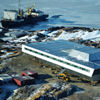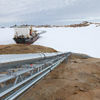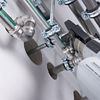Minus 40 °C – Heating and water even in extremely unwelcoming locations
On the rocky Antarctic plateau adjacent to the Larsemann Hills, at temperatures down to minus 40 °C, India has been operating a science research station since 2012. It is named "Bharati", after the Hindu Goddess of Wisdom and Knowledge. For wisdom and knowledge to flourish even on the most isolated and hostile continent, it is vital that the team of scientists is realiably supplied with heat and water.
A special task: Glycol in the heating water
Kerosene is used to generate heat and power, because it remains liquid down to minus 54 °C. To aerate the tank, the engineers installed the Viega Sanpress Inox G piping system – because of its permanent resistance to the media being transported. Sanpress Inox G is usually used for gas and heating oil pipes.
The Prestabo system was used for the heating installation. To prevent the heating water from freezing, a 57 percent glycol-L additive is mixed into it. For the project, Viega tested the reaction of the EPDM sealing rings to such extremely high glycol content levels. The end result: The sealing rings of the press connectors are fully usable for the heating water/glycol mix. And they are also suitable for operating temperatures from minus 40 °C up to an at the Bharati station rather less likely plus 80 °C.
Where legionella poses a risk to an entire mission
Drinking water hygiene is particularly vital at the remote location. Contamination by legionella or similar harmful microbes would be disastrous not only for the researchers – the very future of the mission would be placed at risk.
That is why the planners chose Sanpress Inox with pipes made of stainless steel 1.4521. Easytop circulation regulating valves ensure that the hot water is kept at a constant 60 °C. Their thermal disinfection system provides effective protection against legionella. Easytop extraction valves enable regular monitoring of drinking water quality.
Some 25 people will be working under extreme conditions at the Bharati station all year round for at least 20 years – in part thanks to technology Made in Germany.



